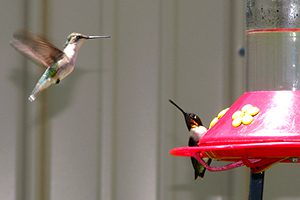Common Questions for Fall Backyards

Hummingbirds by Kerry Wixted
Five often-asked questions answered here!
When is the best time of year to remove my hummingbird feeder?
It is best to leave your hummingbird nectar feeders up as long as the hummingbirds are around. A common myth states that leaving up feeders too long will prevent hummingbirds from migrating. That is simply not true. Generally, I suggest leaving feeders up until Oct. 1 in Maryland. If you are still seeing hummingbird activity at that time, leave the feeder up another 1-2 weeks until activity dies down. Very rarely, young hummingbirds will overwinter in the area. Make sure to keep those feeders clean, too!
Can I sow wildflower seeds in the fall?
Yes! Fall is a great time to sow seeds for many of our local wildflowers.
What are the best types of seeds to feed birds?
With lots of different types of seeds on the market, it can be hard to choose which will work best for your backyard and local birds. Check out our previous HabiChat on selecting the right seed here. If you feed the birds through the winter, consider signing up and reporting your finds to Project FeederWatch, which begins in November.
I want to watch the fall hawk migration but don’t know where to start. Can you help?
Sure! For a great guide to all things related to hawk migration (including identification guides), check out the Hawk Migration Association of North America. You can also check for local hawk watching trips or find hawk hotspots on the Maryland Ornithological Society
When and how can I winterize nest boxes?
During this time of year, few birds are still nesting. If your nest box is unoccupied, consider winterizing it now.
Author’s note
I love fall. As the days grow shorter and the temperature starts to dip, wildlife activity in the garden often intensifies. Animals that stay during the winter are busy caching food and fattening up, while others are fueling up to travel long distances to warmer climates.
In this issue of HabiChat, we’ll focus on a native fruit tree known as the paw-paw, a favorite fruit of George Washington and an excellent food source for many mammals. In addition, you can learn about potter wasps and their unique nest structures that can be found around local gardens, as well as ways to bewitch local butterflies and moths (Lepidoptera) to overwinter in your yard. Finally, we have a quick list of common questions that often pop up in the fall.
Happy Habitats!
Kerry Wixted
Click here to have HabiChat—the quarterly backyard wildlife habitat newsletter from the Wild Acres program—delivered right to your inbox!
In this Issue:
Bewitching Butterflies and Moths
Common Questions for Fall Backyards
Paw-Paw (Asimina triloba)
Potter Wasp (Eumenes fraternus)


 1-888-373-7888
1-888-373-7888 233733
233733